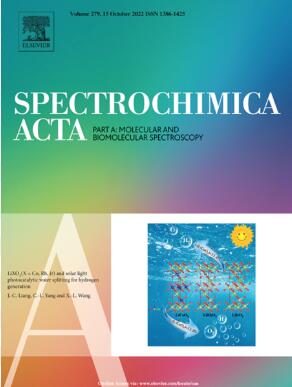Label Free AIEE-Driven Fluorescent Probe for Oxytetracycline: Integrating TD-DFT Study, Fingerprint Analysis and Devising Portable Sensing Strategy
IF 4.6
2区 化学
Q1 SPECTROSCOPY
Spectrochimica Acta Part A: Molecular and Biomolecular Spectroscopy
Pub Date : 2025-07-01
DOI:10.1016/j.saa.2025.126633
引用次数: 0
Abstract
Deferasirox based fluorescent probe DSA was accomplished through convenient synthetic method. Probe DSA exhibited the aggregation induced emission enhancement features along with the formation of “J-type aggregates”. Maximum emission wavelenghth of the probe DSA was observed at 505 nm in H2O/DMF. The absoption and emission spectral results of DSA probe were also drawn from the theoretical analysis through time dependent density functional theory (TDDFT). Theoretical spectral results were found exactly similar to the results obtained from experimental studies. The probe DSA sensitively and selectively detected the oxytetracycline showing the limit of detection of 70 nM. Probe DSA demonstrated PET based fluorescence quenching mechanism for sensing of OTC. DSA-OTC interaction was checked through UV–Vis. fluorescence and 1H NMR titration analysis experimentally. The interaction between the DSA and OTC was non-covalent in nature which was further elucidated by performing the density functional theory (DFT) studies. Practical applicabilty was determined in human plasma and milk samples. The finger print identification through DSA was also analyzed under UV light (365 nm). DSA was practically utilized as fluorescent ink.

无标签aiee驱动的土霉素荧光探针:结合TD-DFT研究、指纹分析和设计便携式传感策略
采用简便的合成方法制备了去铁胺荧光探针DSA。探针DSA表现出聚集诱导的发射增强特征,并形成“j型聚集体”。在H2O/DMF中,探针DSA的最大发射波长为505 nm。利用时间相关密度泛函理论(TDDFT)对DSA探针的吸收光谱和发射光谱进行了理论分析。理论光谱结果与实验研究结果完全一致。该探针对土霉素的检测限为70 nM,灵敏度高,选择性好。探针DSA显示了基于PET的荧光猝灭机制。通过UV-Vis检测DSA-OTC的相互作用。荧光和1H NMR滴定分析实验。DSA与OTC之间的相互作用本质上是非共价的,这一点通过密度泛函理论(DFT)的研究得到了进一步的阐明。在人血浆和牛奶样品中确定了实际适用性。并在365 nm紫外光下进行指纹识别分析。DSA被实际用作荧光油墨。
本文章由计算机程序翻译,如有差异,请以英文原文为准。
求助全文
约1分钟内获得全文
求助全文
来源期刊
CiteScore
8.40
自引率
11.40%
发文量
1364
审稿时长
40 days
期刊介绍:
Spectrochimica Acta, Part A: Molecular and Biomolecular Spectroscopy (SAA) is an interdisciplinary journal which spans from basic to applied aspects of optical spectroscopy in chemistry, medicine, biology, and materials science.
The journal publishes original scientific papers that feature high-quality spectroscopic data and analysis. From the broad range of optical spectroscopies, the emphasis is on electronic, vibrational or rotational spectra of molecules, rather than on spectroscopy based on magnetic moments.
Criteria for publication in SAA are novelty, uniqueness, and outstanding quality. Routine applications of spectroscopic techniques and computational methods are not appropriate.
Topics of particular interest of Spectrochimica Acta Part A include, but are not limited to:
Spectroscopy and dynamics of bioanalytical, biomedical, environmental, and atmospheric sciences,
Novel experimental techniques or instrumentation for molecular spectroscopy,
Novel theoretical and computational methods,
Novel applications in photochemistry and photobiology,
Novel interpretational approaches as well as advances in data analysis based on electronic or vibrational spectroscopy.

 求助内容:
求助内容: 应助结果提醒方式:
应助结果提醒方式:


